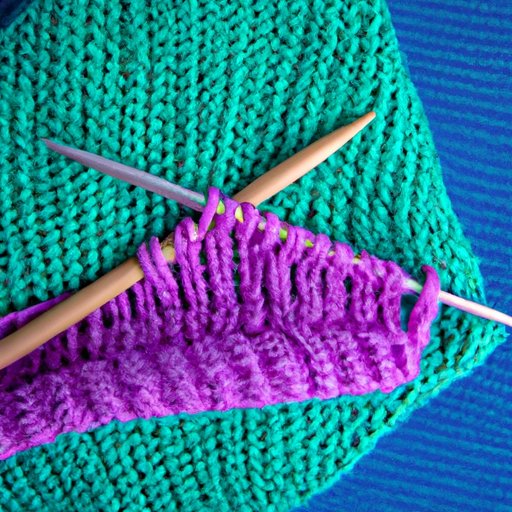
Introduction
Knitting is a relaxing and rewarding hobby that allows for creativity and handmade creations. However, mastering different knitting stitches can be challenging. The purl stitch is one of the most fundamental knitting techniques necessary for creating various projects. It might seem daunting and confusing, but with a little bit of practice and patience, anyone can learn it. In this article, we will explore everything you need to know about purl stitch, from simple steps to advanced techniques.
Mastering the Purl Stitch: A Beginner’s Guide to Knitting
Purl stitch is the exact opposite of knit stitch. Instead of creating loops around the needle from left to right, you will be creating loops from right to left. It creates a bumpy texture, which is perfect for creating scarfs, sweaters, and many other things.
Here are the step-by-step guidelines for mastering the purl stitch:
1. Insert the needle purl-wise into the first stitch
2. Take the working yarn and wrap it around the right needle counterclockwise
3. Carefully pull the right needle down and pass it through the stitch on the left needle
4. Keeping it pointed down, slide the left stitch off the left-hand needle
5. Repeat the process until you have completed the desired number of stitches.
10 Simple Steps to Perfect Your Purl Stitch
Like most skills, perfecting purl stitch requires practice. Here are ten tips that will help ensure that you do the perfect purl stitch every time.
1. Always hold the working yarn firmly with your left hand to prevent it from becoming too loose or too tight.
2. Always insert the needle clockwise into the stitch to ensure that the loop is formed correctly.
3. Make sure that the right needle is pointing downwards when you slide the stitch off the left-hand needle
4. Keep your tension even. If it’s too tight, your knitted fabric will end up bunching up; if it’s too loose, the stitches will spread out.
5. Try to keep the width of the stitch as consistent as possible.
6. Avoid splitting the yarn by carefully positioning the needle tip.
7. When switching between knit and purl stitches, it’s best to hold the yarn up and over the needle to avoid creating an unwanted gap.
8. Use stitch markers if you’re working on a large project to help you keep track of your progress.
9. Keep track of the number of rows you complete by using a stitch counter or making a note of it on a piece of paper.
10. Finally, practice, practice, practice. The more you do it, the better you’ll become.
Knitting Mistakes to Avoid: A Guide to the Perfect Purl Stitch
Beginners often make some common mistakes when learning to purl stitch, which can affect the appearance of their knitted projects.
Some common purl stitch mistakes include:
1. Forgetting to wrap the yarn counterclockwise around the needle will result in a twisted stitch.
2. Uneven tension leads to bumpy or tight stitches.
3. Purling too loosely results in stretched-out stitches.
4. Creating a hole in the stitch by not pulling the yarn tight enough.
5. Holding the yarn too tightly can lead to cramped fingers and inconsistent stitches.
Fortunately, all these mistakes are easily avoidable with a little bit of practice and patience.
Purl Stitch for Dummies: Tips and Tricks to Get it Right Every Time
If you’re entirely new to purl stitch, don’t worry, it’s not that complicated. Here are some tips and tricks that will help you master purl stitch quickly.
1. Start with small projects first, like a scarf or dishcloth.
2. Begin by practicing purl stitch alone before combining it with knit stitches.
3. Watch videos or take online courses for additional help.
4. Use brightly colored yarn, so the stitches are easier to see.
5. Use stitch markers to help keep track of progress.
From Novice to Expert: A Comprehensive Guide to Purl Stitch Knitting
Once you’re comfortable with the basics of purl stitch, try these tips and tricks for advanced knitting skills:
1. Experiment with different stitch patterns, such as seed stitch and ribbing.
2. Try using different types of needles, such as circular or double-pointed needles.
3. Add more complex techniques, like cabling or lace stitching, to your projects.
4. Incorporate purl stitch into different areas of your knit fabric, such as the cuffs or neckline.
5. Join a knitting community or attend local knitting events to learn from experts.
Beyond the Basics: Creative Ways to Incorporate the Purl Stitch in Your Knitting Projects
If you’re looking for ways to take your knitting projects to the next level, incorporating purl stitches creatively can add a lot of visual interest and texture. Here are some examples to inspire your creativity:
1. Use different colors of yarn to create textured stripes in a scarf or blanket.
2. Mix purl stitches with knit stitches to create beautiful ribbing patterns on a sweater or hat.
3. Create a basket-weave texture by alternating knit and purl stripes.
4. Use purl stitch to create intricate lace patterns on shawls or wraps.
5. Make beautiful, cozy cables by combining knit, purl, and twist stitches.
Conclusion
Purl stitch is a fundamental knitting technique that every knitter should master. With a little bit of practice and patience, anyone can learn purl stitch and create beautiful knitted projects. Remember, the most important thing is to keep practicing and not to give up. Whether you’re a beginner or an expert, there is always something new to learn about purl stitch and knitting. Resources like online videos, knitting communities, and classes can help you continue to grow and improve your knitting skills.





